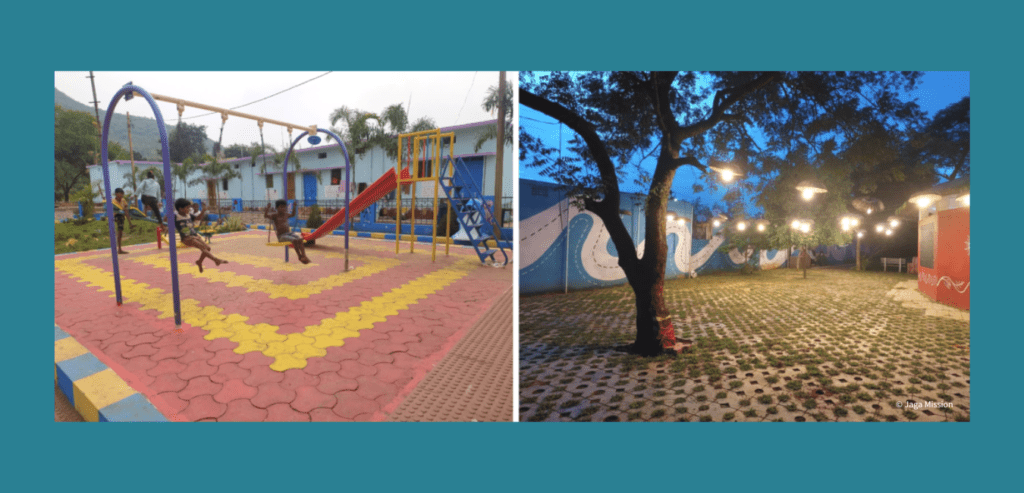Author: Sudeshna Chatterjee
In our latest from our Ask an Expert series, we speak with Sudeshna Chatterjee, a globally recognised urban practitioner and researcher about what it takes to enable inclusive, resilient and child-sensitive urbanisation in low-and middle-income countries.
Can you describe your journey into children’s environments?
I grew up in Kolkata in India, in a neighbourhood with no public open space. Still, many private green driveways, rooftops and courtyards were accessible to neighbourhood children. There was also a large private school ground open to the community, including children from a nearby slum, after school hours. By the time I was a teenager, the school land had been sold off and turned into a block of flats. Early on I understood the causal relationship between unchecked urbanisation and the retreat of children indoors.
I came across Kevin Lynch’s work on Growing Up in Cities when I was studying for a Master’s degree in urban design. I decided to adopt the methodology to work with children in different neighbourhoods in Kolkata and a group of street children at a railway station. I used the findings to redesign the neighbourhood where I grew up, under the guidance of a group of children.
This work deeply impacted me and shaped my career to focus on improving cities for children. I worked on securing the housing rights of children and was a witness to the struggles of families facing forced evictions. Later, in my PhD dissertation, I deconstructed the idea of the child-friendly city by asking whether it is indeed possible for children to form a friendship with place. Through fieldwork in India, I explored the possibility of making cities child friendly for disadvantaged urban children.
My career has ranged across research, urban planning, urban design and teaching. But I like to think of myself as a bridge builder between communities of knowledge and practice.
In 2011, I set up Action for Children’s Environments (ACE) as a non-profit trust to engage with the broader questions of environment, development and urbanisation as they relate to children and young people. As a national partner of UNICEF India, ACE shaped several city-based programmes for vulnerable children. Notably, these projects helped to strengthen the evidence base beyond official data through child-led participatory mapping.
At the invitation of the International Play Association (IPA), I was involved in the drafting of the General Comment 17 on article 31 (right to play) of the UN Convention on the Rights of the Child (CRC) along with other experts. GC 17 has motivated many local governments around the world to plan for play (such as Regensburg, Barcelona, Mexico City and Sharjah). It has also prompted the UNICEF Child Friendly Cities Initiative to include the right to play as a key programming pillar in its revised new framework.
However, the CRC committee was very concerned about the little attention paid to children’s play in situations of crisis, a concern that IPA shared. I worked with IPA in leading an international research project called Access to Play in Crisis (APC) involving six countries to address the gaps in knowledge and provide recommendations. The research contributed to the development of training resources by IPA for humanitarian actors and is widely used around the world.
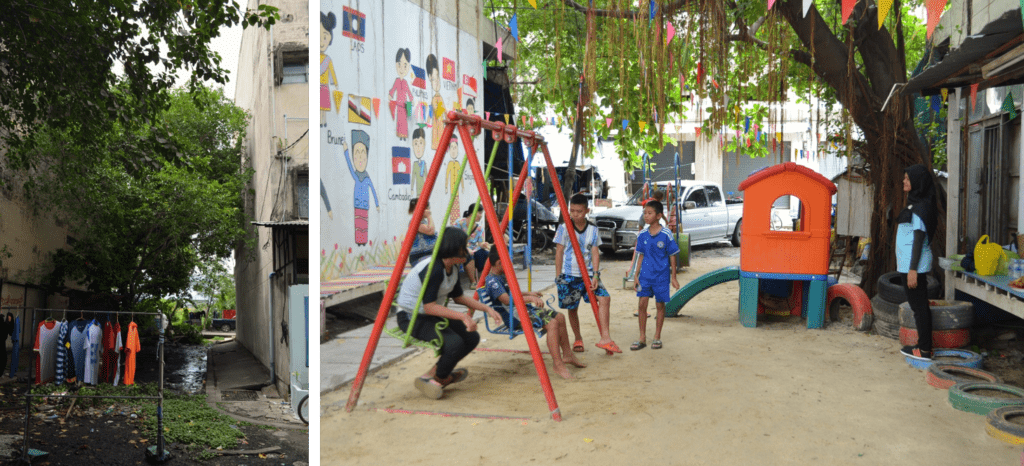
In the heart of a marginalised Burmese migrant community, a community-built playground has been made by reclaiming a swampy leftover space in Bangkok, Thailand © Sudeshna Chatterjee/APC project, IPA
In 2019, I got the opportunity to co-lead the first corporate evaluation of UNICEF’s Work on Children in Urban Settings, with case studies in five countries to look at different urban programming approaches. The evaluation is helping to revise and update UNICEF’s urban strategic note and urban programming.
In the course of this work, I became increasingly interested in working on urban systems to scale up good ideas. And in my most recent work on the Global Principles and Guidance for Public Spaces for Children, we asked what are ‘successful’ places for children in different contexts, from planned environments and informal settlements to disaster and humanitarian emergencies? And what are the rationale, drivers and pathways to produce them?
In your opinion, with respect to India and other low- and middle-income countries, what has worked well and what has not in creating better cities for children?
The international attention on making cities better for children has certainly made children’s issues much more visible to government stakeholders. This includes countries in the global South, where some international donors have created large or highly visible programmes.
One positive outcome is a growing acknowledgement of the importance of public spaces for children and the right to play. This has resulted in the improvement of safety and walking environments in school zones and play environments for children in municipal parks, playgrounds, streets and civic spaces. However, scaling up these initiatives is a big challenge.
One interesting approach has been study tours abroad for government officials, organised by many donors. These have resulted in some innovative pilot projects once these officials return to their home countries. But in most cases, they remain just that: one-off pilot projects. In some very unfortunate cases, ideas learnt abroad have been translated in ways that distort the core values and principles to produce inequitable and exclusionary solutions.
One example is a new pay-per-use ‘public’ playground in New Delhi. It has prohibitory signs that effectively exclude poor children (‘barefooted children not allowed in the play area/park’) and that tell children how to play (‘no climbing on the outside of the play equipment’). Yet this eye-catching playground was seen as a showcase project built on a large tract of public land far away from low-income housing without any local needs assessment after a study tour to European countries.
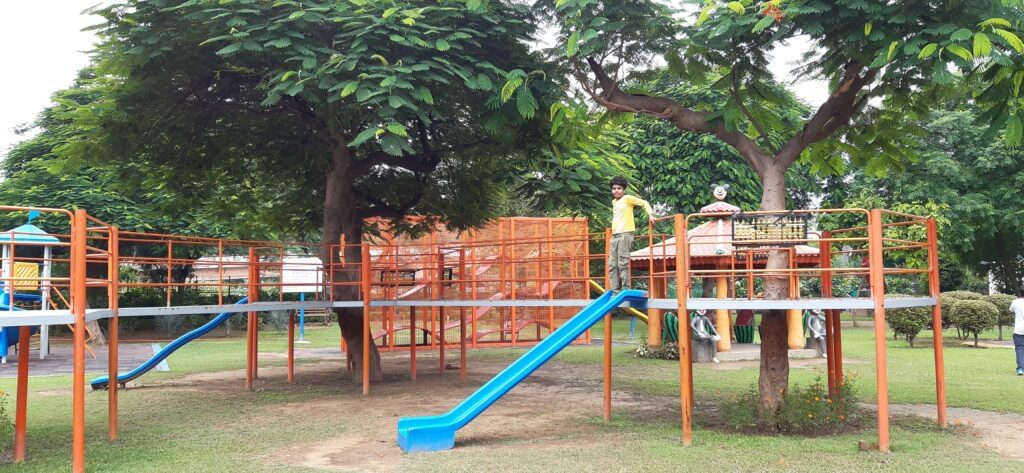
A new pay-per-use public playground in New Delhi that excludes ‘barefooted children’ © Sudeshna Chatterjee
What needs to happen differently? Who can play a role in shaping cities for children – and how?
Governments at different scales, civil society and communities – including children themselves – all have a role to play in shaping cities.
Different drivers and pathways can be used by different stakeholders to conceptualise, plan, implement, monitor and sustain citywide plans and programmes that shape cities for children.
The Delhi playground example given above underscores the importance of understanding the political economy and ingrained cultures within public administrations. To avoid repeating mistakes like these, we need to invest in inclusive planning processes before jumping to solutions.
In the global South, where rapid urban growth often happens in the absence of industrialisation and sufficient resources, even the largest cities can lag behind in basic infrastructure. Much of the built environment is also typically produced in the absence of secure tenure and through incremental construction, most often in defiance of building codes and land-use regulations, and without formal finance. There is a strong causal relationship between insecure tenure and multiple deprivations for children. But governments are reluctant to provide basic services and social infrastructure – such as schools and health centres – in informal settlements that occupy land zoned for non-residential use.
In many cities, non-governmental organisations (NGOs) and community-driven organisations have engaged with governments to address these issues through negotiation or legal channels. The Mukuru slum in Kenya is a good example. Here, a multistakeholder partnership was created to produce an integrated development plan for the Mukuru Special Planning Area (SPA). It involves residents, local government and over 40 organisations all working together in large-scale collaborative community planning initiatives.
What are the biggest challenges to making cities better for/with children at scale?
Lack of funding and capacity of local governments: Decentralisation is an incomplete project in most countries in the global South. The responsibility for many urban functions is often devolved to the municipal level but lacks the financial or human resources to support it. This severely impacts the ability of urban local bodies to provide basic services to children and their families, with life-long consequences for children’s health and development.
Interconnected and unaddressed urbanisation, planning and environmental issues: An array of related factors diminishes the lives of many children in urban areas, affecting their safety, health and opportunities. These factors include the lack of city-scale planning or municipal investment in public spaces, a disregard for equity and inclusion, the lack of safe local play spaces or safe mobility, and inadequate waste management. There is also a lack of concern for the environment or for low-carbon, climate-resilient equitable solutions in market-driven urban projects.

Children engaging in risky play near a planned slum resettlement housing project in Mumbai, where no attention has been paid to public spaces for children © Sudeshna Chatterjee
Lack of mandates for regional planning: Many cities have declining centres due to reasons such as the flight of jobs and labour to the underserved peripheries where land is cheaper. For that same reason, new migrants settle in the peripheries even in the absence of jobs. Metropolitan expansion needs to be seen from the perspective of planning for a liveable, well-connected metropolitan region. But, for example in India, there are no clear mandates for states, development authorities or districts to undertake regional planning. The result is underserved urban peripheries and disconnected resource-trapped small towns that undermine the quality of children’s lives.
Lack of political voice for children and their families: As all child-focused organisations know, children do not have a political voice – and this affects their ability to influence decision-making. Poor families in particular tend to have limited political power.
What is your advice to international organisations working with national and local governments to enable child- and youth-inclusive urbanisation?
Despite the trend towards decentralisation, there are still nations where national and/or state governments continue to control urban areas. Moreover, ‘urban’ is not one sector but a cross-cutting one with multiple policies, accountabilities and jurisdictions.
The first thing to do for any organisation working with urban children is to conduct a landscape analysis of the urban governance system in the country to understand horizontal arrangements across sectors and the vertical arrangements across municipal, metropolitan, provincial, regional/state and national governments for policy alignments, collaborations and financial flows.
There is also a tendency to engage consultants to advise urban improvements and create child-friendly solutions based on global best practices. But too often, there is very little time or interest to consider local needs and preferences – or to co-create solutions through participatory processes and invest in planning for sustainability. Unrealistic deadlines also compromise quality.
The message I want to give is this: invest time and resources to find the right solutions for the difficult urban challenges facing children – and involve children.
Successful projects typically see different stakeholders coming together to form strong and diverse partnerships, with good leadership, institutional reforms and a long-term vision with achievable intermediate goals.
Moreover, for projects and programmes to survive political change, it is essential to share well-documented programme insights with new administrations. Closely monitor and evaluate pilots, projects and programmes and improve feedback loops. This will also improve the relevance and effectiveness and enhance the impact of programmes.
Given the financial challenges of local governments, international organisations can play an important role in supporting public financial management for children in cities. UNICEF has some experience in tracking the budgets and flow of funds from national, regional/state and provincial governments to municipal governments in Gujarat, India as well as in the Philippines.
What is your advice to national and local governments to enable child- and youth-inclusive urbanisation?
- Generate geographically disaggregated data to enable an analysis of inter- and intra-urban disparities to capture child well-being across various sectors and spatial locations.
- Spatialise data on urban children’s vulnerability to better target different policies, programmes, infrastructure and services.
- Ensure local government budgets are adequate for fulfilling children’s rights and allocate funds to benefit the children most in need.
- Promote child-responsive urban planning by engaging with a wide range of stakeholders and facilitate children’s participation in developing public spaces and community public facilities.
- Synchronise citywide slum-upgrading programmes with sectoral strategies in health, housing, employment, transport and social inclusion, and adopt an integrated approach to community development in slums.
- Enhance service delivery and coordination by partnering with the private sector and civil society including NGOs to bring efficiency and equity to service provision for disadvantaged children and families.

Examples of spatialising sanitation through GIS mapping undertaken in a Kolkata ward involving children and the community © ACE Trust
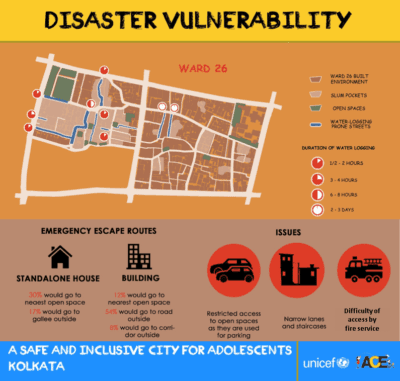
Examples of spatialising vulnerability through GIS mapping undertaken in a Kolkata ward involving children and the community © ACE Trust
Can you share an example from India that you have found inspiring?
A fine example is the Odisha State government-led and funded Jaga Mission, a slum-upgrading programme that acknowledges residents as city makers. The programme not only grants land rights and secure tenure to slum dwellers across all 115 cities in the state of Odisha but also upgrades houses, streets, basic services and infrastructure, and promotes the creation of community public spaces that support children’s play. Almost 600 slums have been upgraded already. Key enabling factors include precise targeting through mapping, awareness building, effective representation of different groups in the decision-making processes, and supporting slum dweller associations to become implementation partner.

A play space (left) and well-lit, paved and improved internal streets were created through slum upgrading via the Jaga Mission in Odisha © Jaga Mission
What else would you like to share?
It is imperative to have strong integrated programming spanning many sectors to improve urban children’s lives.
This should be built on a foundation of equity and inclusion, addressing the many urban challenges related to urbanisation, planning and the environment, and engaging with urban governance systems. It is so important to invest in the right processes to get the desired outcomes that leave no child and no adolescent behind.
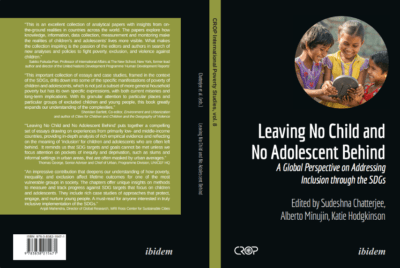
Download the book at https://bora.uib.no/bora-xmlui/handle/11250/2985007
Dr Sudeshna Chatterjee has extensive experience as a globally recognised urban practitioner, evaluation specialist, researcher, and published author. She focuses on enabling inclusive, resilient and child-friendly cities and communities and advocating for including child and youth perspectives in urban policies, planning and urbanisation processes. Sudeshna founded a research-based design practice and a non-profit focusing on action research to improve children’s environments. She also recently led the research and writing of the Global Principles and Guidance for Public Spaces for Children supported by United Nations Children’s Fund (UNICEF), the United Nations Human Settlements Programme (UN-Habitat) and the World Health Organization (WHO). She is currently serving as the programme director for Sustainable Cities and Transport at the World Resources Institute (WRI) India Ross Centre for Cities. All opinions expressed in this blog are personal.
In our Ask An Expert series we interview key figures in the urban space. We ask them about their work, but also about their informed opinions on how we can all improve children’s lives in cities. Read more of our blogs here.
This work is licensed under a Creative Commons Attribution-NonCommercial-NoDerivatives 4.0 International License. When re-sharing this content please ensure accreditation by adding the following sentence: ‘This blog was first published by the Global Alliance – Cities4Children.‘

